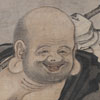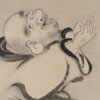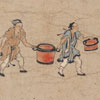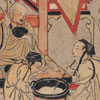Many, like the ninth-century priest Kūkai, returned from study in China with texts and images that immediately were copied for ritual use. Soon, Japanese temples were replete with awe-inspiring sculptural and painted representations selected from Buddhism's pantheon of deities, including cosmic Buddhas, bodhisattvas, heavenly kings, and guardians of the faith. In addition to adopting such iconic imagery, the Japanese also produced splendid objects for use in religious rituals and observances.
The rise of the Zen sect in the thirteenth century heralded profound changes in Japanese religious art. In a radical departure from previous practices, in which professional painters produced highly detailed and brightly pigmented images, Zen monks began to render simple depictions of their spiritual paragons in diluted ink. These images, as well as calligraphy, were believed to embody the enlightened mind of the prelates who produced them and were carefully collected and preserved by their devoted followers. Later, professional artists who produced bold images of Chinese Confucian and Daoist sages in addition to Buddhist subjects adopted the practice of painting in pure ink. Such images, often more secular than religious, were used to decorate the castles and palaces of wealthy patrons interested in Chinese culture.






















